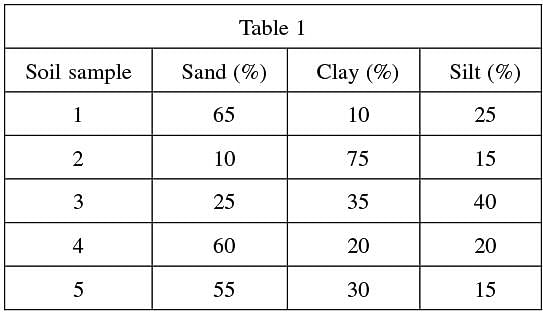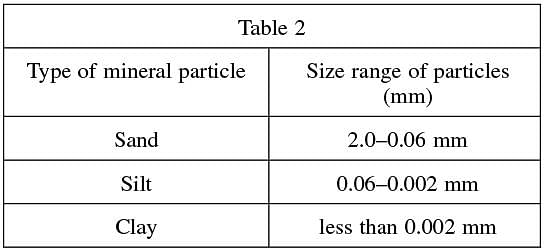ACT Exam > ACT Questions > Directions:Read the passages and choose the b...
Start Learning for Free
Directions: Read the passages and choose the best answer to each question.
Passage
Students in a science class collected soil samples from various locations in order to analyze the composition of the soil. They measured the percentage of the three types of soil minerals—sand, silt, and clay—in each sample. Their data is presented in Table 1. The students also measured the size of the mineral particles found in the soil samples. The particle size ranges are listed in Table 2.


Passage
Students in a science class collected soil samples from various locations in order to analyze the composition of the soil. They measured the percentage of the three types of soil minerals—sand, silt, and clay—in each sample. Their data is presented in Table 1. The students also measured the size of the mineral particles found in the soil samples. The particle size ranges are listed in Table 2.


Q. Sample 2 would most likely, if measured, have an average mineral particle size of:
- a)1.5 mm.
- b)1.0 mm.
- c)0.06 mm.
- d)0.001 mm.
Correct answer is option 'D'. Can you explain this answer?
Most Upvoted Answer
Directions:Read the passages and choose the best answer to each questi...
The best answer is D. According to Table 1, Sample 2 is made mostly of clay (75%). Table 2 shows that clay particles are less than 0.002 millimeters in size. The only answer choice with a size of less than 0.002 millimeters is answer choice D.

|
Explore Courses for ACT exam
|

|
Similar ACT Doubts
Directions:Read the passages and choose the best answer to each question.PassageStudents in a science class collected soil samples from various locations in order to analyze the composition of the soil. They measured the percentage of the three types of soil minerals—sand, silt, and clay—in each sample. Their data is presented in Table 1. The students also measured the size of the mineral particles found in the soil samples. The particle size ranges are listed in Table 2.Q.Sample 2 would most likely, if measured, have an average mineral particle size of:a)1.5 mm.b)1.0 mm.c)0.06 mm.d)0.001 mm.Correct answer is option 'D'. Can you explain this answer?
Question Description
Directions:Read the passages and choose the best answer to each question.PassageStudents in a science class collected soil samples from various locations in order to analyze the composition of the soil. They measured the percentage of the three types of soil minerals—sand, silt, and clay—in each sample. Their data is presented in Table 1. The students also measured the size of the mineral particles found in the soil samples. The particle size ranges are listed in Table 2.Q.Sample 2 would most likely, if measured, have an average mineral particle size of:a)1.5 mm.b)1.0 mm.c)0.06 mm.d)0.001 mm.Correct answer is option 'D'. Can you explain this answer? for ACT 2025 is part of ACT preparation. The Question and answers have been prepared according to the ACT exam syllabus. Information about Directions:Read the passages and choose the best answer to each question.PassageStudents in a science class collected soil samples from various locations in order to analyze the composition of the soil. They measured the percentage of the three types of soil minerals—sand, silt, and clay—in each sample. Their data is presented in Table 1. The students also measured the size of the mineral particles found in the soil samples. The particle size ranges are listed in Table 2.Q.Sample 2 would most likely, if measured, have an average mineral particle size of:a)1.5 mm.b)1.0 mm.c)0.06 mm.d)0.001 mm.Correct answer is option 'D'. Can you explain this answer? covers all topics & solutions for ACT 2025 Exam. Find important definitions, questions, meanings, examples, exercises and tests below for Directions:Read the passages and choose the best answer to each question.PassageStudents in a science class collected soil samples from various locations in order to analyze the composition of the soil. They measured the percentage of the three types of soil minerals—sand, silt, and clay—in each sample. Their data is presented in Table 1. The students also measured the size of the mineral particles found in the soil samples. The particle size ranges are listed in Table 2.Q.Sample 2 would most likely, if measured, have an average mineral particle size of:a)1.5 mm.b)1.0 mm.c)0.06 mm.d)0.001 mm.Correct answer is option 'D'. Can you explain this answer?.
Directions:Read the passages and choose the best answer to each question.PassageStudents in a science class collected soil samples from various locations in order to analyze the composition of the soil. They measured the percentage of the three types of soil minerals—sand, silt, and clay—in each sample. Their data is presented in Table 1. The students also measured the size of the mineral particles found in the soil samples. The particle size ranges are listed in Table 2.Q.Sample 2 would most likely, if measured, have an average mineral particle size of:a)1.5 mm.b)1.0 mm.c)0.06 mm.d)0.001 mm.Correct answer is option 'D'. Can you explain this answer? for ACT 2025 is part of ACT preparation. The Question and answers have been prepared according to the ACT exam syllabus. Information about Directions:Read the passages and choose the best answer to each question.PassageStudents in a science class collected soil samples from various locations in order to analyze the composition of the soil. They measured the percentage of the three types of soil minerals—sand, silt, and clay—in each sample. Their data is presented in Table 1. The students also measured the size of the mineral particles found in the soil samples. The particle size ranges are listed in Table 2.Q.Sample 2 would most likely, if measured, have an average mineral particle size of:a)1.5 mm.b)1.0 mm.c)0.06 mm.d)0.001 mm.Correct answer is option 'D'. Can you explain this answer? covers all topics & solutions for ACT 2025 Exam. Find important definitions, questions, meanings, examples, exercises and tests below for Directions:Read the passages and choose the best answer to each question.PassageStudents in a science class collected soil samples from various locations in order to analyze the composition of the soil. They measured the percentage of the three types of soil minerals—sand, silt, and clay—in each sample. Their data is presented in Table 1. The students also measured the size of the mineral particles found in the soil samples. The particle size ranges are listed in Table 2.Q.Sample 2 would most likely, if measured, have an average mineral particle size of:a)1.5 mm.b)1.0 mm.c)0.06 mm.d)0.001 mm.Correct answer is option 'D'. Can you explain this answer?.
Solutions for Directions:Read the passages and choose the best answer to each question.PassageStudents in a science class collected soil samples from various locations in order to analyze the composition of the soil. They measured the percentage of the three types of soil minerals—sand, silt, and clay—in each sample. Their data is presented in Table 1. The students also measured the size of the mineral particles found in the soil samples. The particle size ranges are listed in Table 2.Q.Sample 2 would most likely, if measured, have an average mineral particle size of:a)1.5 mm.b)1.0 mm.c)0.06 mm.d)0.001 mm.Correct answer is option 'D'. Can you explain this answer? in English & in Hindi are available as part of our courses for ACT.
Download more important topics, notes, lectures and mock test series for ACT Exam by signing up for free.
Here you can find the meaning of Directions:Read the passages and choose the best answer to each question.PassageStudents in a science class collected soil samples from various locations in order to analyze the composition of the soil. They measured the percentage of the three types of soil minerals—sand, silt, and clay—in each sample. Their data is presented in Table 1. The students also measured the size of the mineral particles found in the soil samples. The particle size ranges are listed in Table 2.Q.Sample 2 would most likely, if measured, have an average mineral particle size of:a)1.5 mm.b)1.0 mm.c)0.06 mm.d)0.001 mm.Correct answer is option 'D'. Can you explain this answer? defined & explained in the simplest way possible. Besides giving the explanation of
Directions:Read the passages and choose the best answer to each question.PassageStudents in a science class collected soil samples from various locations in order to analyze the composition of the soil. They measured the percentage of the three types of soil minerals—sand, silt, and clay—in each sample. Their data is presented in Table 1. The students also measured the size of the mineral particles found in the soil samples. The particle size ranges are listed in Table 2.Q.Sample 2 would most likely, if measured, have an average mineral particle size of:a)1.5 mm.b)1.0 mm.c)0.06 mm.d)0.001 mm.Correct answer is option 'D'. Can you explain this answer?, a detailed solution for Directions:Read the passages and choose the best answer to each question.PassageStudents in a science class collected soil samples from various locations in order to analyze the composition of the soil. They measured the percentage of the three types of soil minerals—sand, silt, and clay—in each sample. Their data is presented in Table 1. The students also measured the size of the mineral particles found in the soil samples. The particle size ranges are listed in Table 2.Q.Sample 2 would most likely, if measured, have an average mineral particle size of:a)1.5 mm.b)1.0 mm.c)0.06 mm.d)0.001 mm.Correct answer is option 'D'. Can you explain this answer? has been provided alongside types of Directions:Read the passages and choose the best answer to each question.PassageStudents in a science class collected soil samples from various locations in order to analyze the composition of the soil. They measured the percentage of the three types of soil minerals—sand, silt, and clay—in each sample. Their data is presented in Table 1. The students also measured the size of the mineral particles found in the soil samples. The particle size ranges are listed in Table 2.Q.Sample 2 would most likely, if measured, have an average mineral particle size of:a)1.5 mm.b)1.0 mm.c)0.06 mm.d)0.001 mm.Correct answer is option 'D'. Can you explain this answer? theory, EduRev gives you an
ample number of questions to practice Directions:Read the passages and choose the best answer to each question.PassageStudents in a science class collected soil samples from various locations in order to analyze the composition of the soil. They measured the percentage of the three types of soil minerals—sand, silt, and clay—in each sample. Their data is presented in Table 1. The students also measured the size of the mineral particles found in the soil samples. The particle size ranges are listed in Table 2.Q.Sample 2 would most likely, if measured, have an average mineral particle size of:a)1.5 mm.b)1.0 mm.c)0.06 mm.d)0.001 mm.Correct answer is option 'D'. Can you explain this answer? tests, examples and also practice ACT tests.

|
Explore Courses for ACT exam
|

|
Signup for Free!
Signup to see your scores go up within 7 days! Learn & Practice with 1000+ FREE Notes, Videos & Tests.


























